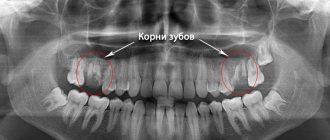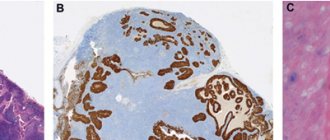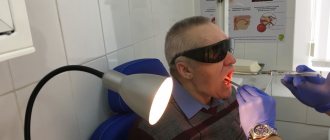Tonsillectomy for most patients with chronic decompensated tonsillitis is the method of choice and often the only treatment. In this regard, tonsillectomy is one of the most common planned operations in ENT surgical practice. This method of surgical treatment, according to various authors, reaches up to 40% of all surgical interventions on the ENT organs [1-3]. Indications for surgical intervention are frequent tonsillitis, as well as local complications of tonsillitis, such as peritonsillar abscess, retropharyngeal abscess, neck phlegmon, suppurating cervical lymphadenitis, febrile convulsions, severe tonsillogenic intoxication, diseases of distant organs and systems associated with pharyngeal pathology [4]. In the postoperative period after tonsillectomy, pain remains extremely relevant and in most cases the only symptom. The causes of pain immediately after tonsillectomy and in the next few days are the extensive open postoperative surface in the tonsillar niches, swelling and infiltration of the palatal arches [5]. The mechanism of post-traumatic pain is associated with an increase in the excitability of nociceptors resulting from the action of algogens - substances released from cells damaged as a result of surgical exposure (histamine, serotonin, ATP, leukotrienes, interleukin-1, tumor necrosis factor, endothelins, prostaglandins, nitric oxide, neurokinin , A, etc.) and formed in the blood plasma (bradykinin). Most often after surgery, patients are bothered by severe sore throat, which often radiates to the ears and also intensifies when swallowing [6]. In these cases, it is necessary to resort to painkillers, as well as follow a special diet that excludes coarse, salty, and spicy foods. Postoperative pain negatively affects the patient's eating and return to active daily life.
In addition, there is a danger of microbial contamination of the wound surface against the background of a decrease in local immunity and anti-infective resistance of inflamed tissues. In this regard, an important problem after tonsillectomy is to reduce the phenomena of reactive inflammation of tissues and reduce the pain syndrome that occurs in response to surgical trauma.
To achieve optimal analgesic effect after tonsillectomy, the use of a large number of different analgesic drugs is required.
According to the literature, over the years of tonsillectomy, multiple attempts have been made to improve pain relief in the postoperative period, both with systemic and local drugs. However, many of them have side effects and are poorly applicable in modern practice.
Opioid use has side effects such as nausea, vomiting, constipation, respiratory depression and severe sedation.
Nonsteroidal anti-inflammatory drugs (NSAIDs) increase the risks of bleeding and gastrointestinal disorders. According to experts, ibuprofen has some advantages in terms of tolerability over other non-steroidal anti-inflammatory drugs [7]. Cyclooxygenase-2 inhibitors (celecoxib) have similar analgesic properties to nonselective NSAIDs and have minimal side effects such as platelet dysfunction and gastrointestinal bleeding. However, one study showed that celecoxib does not provide sufficient analgesic effect after tonsillectomy and also often causes vomiting [8].
H. Tolska et al. [9] conducted a meta-analysis of 29 studies representing a double-blind, placebo-controlled, randomized trial of systemic analgesics used in the postoperative period after tonsillectomy. This study confirmed the beneficial analgesic effects of paracetamol, NSAIDs, dexamethasone, gabapentinoids and dextromethorphan after tonsillectomy on the day of surgery. Dexamethasone in multiple doses had an analgesic effect exceeding 24 hours. However, the use of steroids with high total doses and/or long-term use after surgery should be carried out with caution, taking into account the possible risks. Well-known side effects of systemic corticosteroid therapy (eg, moon face, Cushing's syndrome, diabetes mellitus) develop with long-term treatment. The risk of side effects from short-term, 1-2 weeks, systemic glucocorticosteroid therapy is minimal if treatment is not given to patients with diabetes, glaucoma, cataracts and osteoporosis. However, an increase in blood glucose levels and a rise in blood pressure can be observed during treatment with systemic glucocorticosteroids and in patients without diabetes mellitus or hypertension. A single dose of analgesics or the use of dexamethasone alone does not provide a clinically significant long-term analgesic effect after tonsillectomy.
A. Khan et al. found that gabapentin, pregabalin, and dextromethorphan may be useful in moderate doses as adjuvants to other analgesics. However, gabapentin and pregabalin are antiepileptic drugs, and dextromethorphan is an antitussive drug, and therefore their analgesic effect itself is not justified. Ketamine, an NMDA antagonist used as an anesthetic, can be used for pain relief after surgery. Its use in subanesthetic doses is effective in various types of surgeries to reduce opioid requirements and pain sensitivity. However, a patient receiving ketamine should be under constant medical supervision [10].
Thus, systemic analgesic drugs do not always have a good analgesic effect and in most cases have side effects. In this regard, in order to avoid the systemic effect of NSAIDs and at the same time ensure direct contact of the drug with the mucous membrane of the oral cavity and pharynx, it was necessary to develop local anesthetic drugs.
Topical drugs used in the complex treatment of pathological conditions of the oral cavity and pharynx can be divided into analgesics, anti-inflammatory drugs, antiseptics, drugs with a decongestant effect on the mucous membrane, etc. [11]. Local preparations in the form of lozenges, sprays, and rinses have also begun to be used in patients after tonsillectomy.
Many studies conducted in adult patients after tonsillectomy have shown the therapeutic effectiveness of benzydamine, especially when using a 0.15% mouthwash or spray - rapid relief of sore throat, reflex otalgia, and the absence of secondary bacterial complications were noted. However, in these studies there is mention of such an unpleasant sensation in some patients as a burning sensation in the throat associated with the ethyl alcohol contained in these drugs. This may indicate the irritating effect of these drugs, as well as the risk of bleeding from the tonsil niches [12, 13]. Topical therapy for the oropharynx may include rinsing, spraying, and lozenges. Rinsing with medicinal preparations is effective in treating the oral cavity and the base of the tongue. The use of a spray allows you to irrigate the back wall of the pharynx, however, the use of sprays is not recommended for children under 6 years of age and for patients with bronchial asthma. When assessing the effectiveness of medications in the form of resorption, it was noted that the concentration of active ingredients in the pharyngeal mucosa is higher than when using a spray and rinse. There is also a slower cleansing of the pharyngeal mucosa from drugs when using drugs in a resorption form, which ensures the maintenance of a high concentration of the drug at the site of inflammation [14].
In the search for non-pharmacological analgesia, various types of non-traditional approaches to pain management are being used. One such approach is transcranial electrical stimulation. It has been established that under the influence of this method the sensitivity of peripheral pain receptors decreases. This effect is caused by an increased concentration of β-endorphin circulating in the blood. However, this method has a number of contraindications and reduces the severity of pain for a limited period of time, and it is also economically unprofitable [15].
The use of a visual analogue scale (VAS) to assess pain allows us to assess the level of acute postoperative pain syndrome in patients who have undergone tonsillectomy [16].
In connection with the problem of pain relief for patients in the postoperative period after tonsillectomy, attempts have been made in recent years to produce new, safe, modern drugs. One of these drugs is Arnica Montana C9 (BOIRON) - a homeopathic monocomponent drug of plant origin.
The purpose of the study was to identify the effect of the homeopathic monocomponent herbal preparation Arnica Montana C9 (BOIRON) on the condition of patients who underwent tonsillectomy.
Laser tonsil removal methods
The basis of laser therapy is the use of oscillating single-phase waves with varying degrees of penetration into tissue. Laser tonsil removal is divided into two types:
- Complete tonsillectomy or radical tonsillectomy. This type of operation is indicated only when the tonsils are completely destroyed by infection.
- Laser ablation is the selective removal of the upper layers of tonsil tissue.
Several types of laser are used to remove tonsils. Suitable for tonsillectomy:
- Infrared laser - used to separate and adhesion of tonsil tissue;
- Fiber optic laser – excises along with the almond tissue. It is used when inflammation has affected almost the entire tonsil.
The Carbon Laser (CO2 laser) is used for ablation and allows for an evaporation method that shrinks the tonsils and relieves swelling.
Indications for laser tonsil removal
The reason for removing affected tonsils is the presence of a serious threat to other organs. As a rule, removal of the tonsils is indicated for patients who suffer from tonsillitis more than four times a year, patients for whom non-surgical treatment has not given the desired results, patients with complications such as diseases of the heart, joints, and nervous system. Removal of the tonsils is necessary for patients who have suffered an acute rheumatic attack, as well as for people whose excessive enlargement of the tonsils due to the spread of lymphoid tissue causes breathing or swallowing problems.
When to remove tonsils
Patients of any age, both children and adults, may need to undergo a tonsillectomy procedure. According to experts, a persistent sore throat, difficulty swallowing or the appearance of patchy white blisters on the tonsils are often symptoms of tonsillitis. The tonsils may also become enlarged, leading to snoring, mild fever, and neck pain.
To eliminate these symptoms, the doctor may suggest that the patient have his tonsils removed. Consult your dentist or physician if you have recurring tonsil problems or a sore throat.
Contraindications to laser intervention
Removal of tonsils with a laser is contraindicated for patients with cancer, diseases of the hematopoietic organs, blood clotting disorders, mental and nervous system disorders, and serious heart, liver and kidney diseases.
Manipulations to remove hypertrophied tonsils should be postponed during periods of exacerbation of acute infectious, viral and rheumatoid diseases, the active stage of tuberculosis, diabetes mellitus, hypertension and during female menstruation. In addition, tonsil removal is not performed on pregnant and lactating women and children under 10 years of age.
Preparing for removal
Carrying out a tonsillectomy requires certain preparation. The patient must undergo a preoperative examination, which includes:
- conducting a number of laboratory tests (general blood test, urine test, coagulogram, test for HIV and infections, etc.);
- fluorography;
- ECG;
- taking a smear from the mucous membrane of the tonsils and the back wall of the pharynx;
- sanitation of the oral cavity;
- examination by a therapist and, if necessary, doctors of narrow specializations (rheumatologist, endocrinologist, gynecologist, etc.).
If the patient is taking medications that inhibit blood clotting (anticoagulants), they should be stopped a few days before the tonsillectomy. To relieve anxiety before having your tonsils removed, you can start taking sedatives.
On the appointed day, four to six hours before the intervention, it is necessary to finish eating so as not to provoke a gag reflex, and the anesthesia will work better.
Advantages of the laser method
The laser method is one of the most modern methods of treating tonsils.
- Coagulation of the tonsils that occurs during laser exposure accelerates healing, thereby reducing the possibility of bleeding.
- The duration of the laser operation is up to 30-40 minutes.
- Laser treatment does not leave open wound surfaces.
- Laser tonsillectomy surgery is performed on an outpatient basis and does not require a long recovery period. The patient remains able to work after the operation.
- The operation is performed using local anesthesia
- To minimize trauma and facilitate the recovery period, laser tonsillectomy is usually performed in several stages.
Laser exposure is sterile in nature, it allows you to reduce the risks of negative consequences of the operation and minimize interference in the body using the partial excision method.
Conclusion
Based on the statistical analysis of the comparison of two groups of patients who underwent bilateral tonsillectomy, in patients who received, in addition to the anesthetic drug ketorolac, Arnica Montana C9 (BUARON) for resorption, 5 granules 3 times a day from the 2nd day, the recovery time was significantly reduced . This is indicated, in particular, by a faster time for normalization of body temperature, disappearance of pain and a decrease in the inflammatory reaction in the pharynx after tonsillectomy. This may have a positive effect on the quality of life in the early postoperative period of patients taking the drug Arnica Montana C9 (BOIRON).
The authors declare no conflict of interest.
The authors declare no conflicts of interest.
How is the operation performed?
Three hours before the start of the operation, the patient is not recommended to drink or eat. The patient is placed in a surgical chair, and his pharynx is treated with anesthesia. After the anesthesia takes effect, the doctor directs a special device that uses a laser beam to target the tonsils. To avoid burns and damage to healthy tissue, radiation treatment is carried out in 4-5 approaches, each laser session lasts approximately 10-15 seconds. To prevent bleeding, laser coagulation (sealing) of blood vessels is performed. Tonsil removal is performed when the patient pauses breathing after taking a deep breath. To completely remove purulent deposits, large depressions are artificially expanded, then they are smoothed out, and the scars are excised with a laser. Such manipulations make it possible to create a discharge of the contents of the lacunae of the tonsils. When performing tonsillectomy, purulent deposits of the tonsils are completely eliminated. In some cases, within one to two hours after surgery, to eliminate the risk of complications, the patient is monitored and then sent home. Since laser tonsil removal is the most gentle method of treatment, the doctor can perform this manipulation in several stages.
results
Based on the analysis of changes in average body temperature in two groups, it was revealed that in the 1st group of patients who dissolved the drug Arnica Montana C9 (BOIRON), the temperature in the postoperative period normalized faster, maximally increasing to 37.1 ° C in the morning and 37. 4 °C in the evening (Fig. 2;
Rice. 2. Body temperature of patients in the morning. rice. 3).
Rice.
3. Patients’ body temperature in the evening. Rice. 3. Patients’ body temperature in the evening. Using the Mann-Whitney test, it was shown that the day of normalization of morning body temperature in group 1 occurred statistically significantly earlier than in the control group ( p
-value=0.0002<0.05). However, there was no statistically significant difference in evening body temperature between the groups.
The severity of postoperative pain was assessed using VAS (Fig. 4)
Rice. 4. Visual analog scale for assessing pain intensity. Rice. 4. Visual analog scale for assessing pain intensity. in the morning at rest after waking up, and also with a sip of water. In patients of group 1, the pain subsided faster than in patients of group 2 (Fig. 5).
Rice. 5. Severity of postoperative pain in groups. Rice. 5. Severity of postoperative pain in groups.
Patients in both groups noted in the questionnaire the need to use painkillers (intramuscular injections of Ketorolac), as well as the frequency of use during all 10 days of observation. Patients in group 1 required less painkillers on average: on the 1st day after surgery, 60.9% of patients in group 1 and 85% of patients in group 2. Patients taking the drug Arnica Montana C9 (BOIRON) as much as possible used painkillers 3 times a day from days 1-6, and patients who did not take the drug Arnica Montana C9 (BOIRON) used painkillers 4-5 times a day, which indicates the effectiveness of this drug in the treatment of pain syndrome (Fig. 6 on
Rice.
6. The need to use anesthetic in groups. Rice. 6. The need to use anesthetic in groups. color inset). It is worth noting that in group 1, the day of the end of taking painkillers and the day of the end of postoperative pain occurred statistically significantly earlier than in the control group; in the Mann-Whitney test, the p
-values were 0.0005 and 0.0104, respectively, which are below the established significance threshold of 0.05 (see table).
Dynamics of body temperature, end of pain medication, disappearance of sore throat after bilateral tonsillectomy
When assessing the pharyngoscopy picture, a difference was observed in the severity of swelling of the pharyngeal mucosa in the area of the postoperative wound. Swelling of the mucous membrane of the palatine arches and soft palate was characterized in points from 1 to 3. Where 0 points - no swelling, 1 point - swelling of the mucous membrane of the palatine arches, 2 points - swelling of the soft palate, 3 points - pronounced swelling of the uvula (uvula) . On the first day after surgery, the majority of patients in both groups experienced swelling of the pharyngeal mucosa to varying degrees of severity. On the 4th day in the group of patients receiving Arnica Montana C9 (BOIRON), swelling of the uvula of the soft palate was not observed in any patient. However, in the control group, swelling of the uvula of the soft palate on the 4th day was detected in 5% of patients who underwent tonsillectomy. On the 10th day after tonsillectomy, slight swelling of the palatine arches in group 1 was noted only in 13% of patients, versus 55% of patients in the control group (Fig. 7).
Rice. 7. The severity of edema of the pharyngeal mucosa in groups after tonsillectomy. Rice. 7. The severity of edema of the pharyngeal mucosa in groups after tonsillectomy.
Due to postoperative inflammation in the pharynx, neck lymphadenopathy was observed in a number of patients. In group 1, cervical lymph nodes enlarged and became painful in only 34.8% of patients, compared with the control group, in which cervical lymphadenopathy was observed in 65% of cases ( p
=0.0480 χ2 test).
At the same time, neck lymphadenopathy in the 1st group was predominantly only on the 1st day; by the 4th day it was noted in only 1 (4.3%) patient, while in the control group, by the 4th day, neck lymphadenopathy was diagnosed in 5 (25%) patients (possibly due to the small sample size, no statistically significant differences were found between the groups, but a trend towards a significant reduction in neck lymphadenopathy when using the drug Arnica Montana can be noted; p
= 0.0577).
Recovery period
The quality of the operation depends on the professionalism of the doctor. The laser is a sterile instrument that resists septic inflammation of tissues. Regeneration of the pharyngeal mucosa is restored within two to three weeks, in the absence of burns and extensive wounds. Typically, on the 7th day after laser tonsil removal, a postoperative examination is scheduled with the attending physician. To speed up healing, the patient is prescribed rinsing with a special composition. After tonsil removal, treatment with antibacterial drugs is usually not required. During the first 24 hours after laser treatment, the patient is allowed to drink only cool water. It is recommended to turn to a gentle diet of cool, smooth, soft dishes. It is not advisable to eat hard, spicy, fatty or hot foods. Smoking and drinking alcohol is strictly prohibited. After surgery, the patient should not freeze or be physically overloaded. It is advisable to undergo a course of immunity-strengthening treatment.
Material and methods
The study was carried out in patients with chronic decompensated tonsillitis who were admitted to the Department of Otorhinolaryngology of the St. Petersburg State Medical University named after. acad. I.P. Pavlova for planned surgical treatment. Group 1 included 23 patients aged from 20 to 43 years, who in the postoperative period received NSAIDs (Ketorolac) on demand for pain, as well as a homeopathic monocomponent herbal preparation Arnica Montana C9 (BOIRON) 5 granules 3 times a day for resorption from the 2nd day. The second (control) group of patients included 20 patients aged 19 to 42 years who received only on-demand NSAID therapy (Fig. 1).
Rice. 1. Distribution of patients in groups by age. The two study groups of patients were balanced by gender and age, thus, the studied differences between them reflect the effect of the drug Arnica Montana C9 (BOIRON). All patients underwent classical bilateral tonsillectomy under general anesthesia by the same operating team. In the early postoperative period, a number of criteria were assessed in all patients: body temperature in the morning after waking up and in the evening, the need to use NSAIDs, the amount of their use per day, pain assessment according to VAS, as well as changes in the pharyngoscopic picture and neck lymphadenopathy within 10 days after surgery.
The results of the study were entered into the developed computer database on a personal computer using Microsoft Excel tables. Using the application package Statistica for Windows v.10.0, analysis and statistical processing of the obtained data were carried out, and the parameters of descriptive statistics were determined.
Quantitative indicators were checked for compliance with normal distribution using the Kolmogorov-Smirnov test. For quantitative data having a normal distribution, the arithmetic mean ( M
) and standard deviation (
SD
), which are presented in the format
M
(
SD
); when describing indicators that differ from the normal distribution, medians (Me) were used in the Me format (Q1; Q3) and the lower Q1 (25%) and upper Q3 (75%) quartiles were used as an interval estimate. Qualitative indicators of the study are presented in absolute and relative values (%).
To find differences between normally distributed indicators, t
-Student's t-test.
Formula t
-Student's test:
where M
1 - arithmetic mean of the 1st compared group,
M
2 - arithmetic mean of the 2nd compared group,
m
1 - mean error of the first arithmetic mean,
m2
- mean error of the second arithmetic mean.
Statistical processing of the study results in groups was carried out with determination of significance using the nonparametric Mann-Whitney U test.
Mann-Whitney U test formula:
where n
1 - the number of elements in the 1st sample,
n
2 - the number of elements in the 2nd sample, T
x
- the larger of the 2 rank sums,
nx
- the corresponding sample.
Indicators changing over time were analyzed using paired Student's t test (in the case of normal distribution) or using t
-Wilcoxon test.
To analyze qualitative indicators, the χ2 test with Yates' correction was used (in cases of absolute numbers less than 10); if it was impossible to use it, the Z-test was used for proportions with correction for end points.
The difference between groups was considered statistically significant at p
<0,05.








